For many children, Halloween is a day for dressing up and trick-or-treating, candy and carnivals — but there is also often a great deal of excitement leading up to and surrounding the October festivities. This provides the perfect opportunity for not only giving kids some context around Halloween, but for adding hands-on STEM (science, technology, engineering and math) elements to playful Halloween preparation at home.
Of course, many tried-and-true Halloween projects — from designing DIY decorations to creating gooey concoctions — already incorporate STEM concepts without children even knowing. “I firmly believe that play and hands-on experiences are integral to all learning for all ages,” explains Natasha Wilkerson, an aerospace engineer, STEM educator who holds her doctorate in curriculum and instruction and co-founder of Vivify STEM, a K-12 education company. She adds that when children have an emotional response to a lesson or an activity, whether they are “excited, surprised, frustrated or curious, they are more engaged and willing to learn.”
The benefits of STEM activities
Aside from teaching academic skills in these various in-demand subject areas, STEM activities can naturally engage curiosity and help foster and utilize skills necessary for cognitive development. “With STEM activities, our students are building a growth mindset, critical thinking skills and learning how to work collaboratively and creatively,” notes Wilkerson of how her STEM lessons — which aim to connect classroom subjects to the real world — benefit overall development.
Wilkerson adds that it’s not just the hands-on nature of the activities that are important. “Make sure that your kids are actually thinking when they do an activity instead of mindlessly following the steps,” she suggests. “This comes with asking open-ended questions. ‘Why do you think that happened?’ ‘What should we do next?’ ‘What can we do to improve this?’ This gives you openings to teach some key STEM concepts as they become curious.”
These various STEM- and STEAM-based Halloween activities do just that. (The term STEAM integrates an A for the arts, but creativity and creative thinking permeate both STEM and STEAM learning.) They each provide opportunities for hands-on learning, experimentation and family fun — while maintaining the spooky, tricky, eerie and magical elements of the season (see what we did there!).
Science experiments that excite this Halloween
1. Have oodles of fun making oobleck

Image via The Best Ideas for Kids
With its transformative, almost magical properties, oobleck may just be the perfect material for a Halloween science lesson. What’s oobleck? The site The Best Ideas for Kids explains that it is a non-Newtonian fluid — which means that it is a fluid that can act as either a liquid or a solid, and thus change its viscosity, depending upon how much pressure is applied to it.
Grown-ups can follow the site’s simple steps to combine cornstarch and water to create a cauldron full of this fascinating substance that is sure to peak children’s curiosity. (The ingredients can be initially difficult to mix, so leaving the recipe part in grown-up hands makes it both easier to make and helps prevent cornstarch powder ingestion, inhalation or eye contact.) Add some food coloring, plastic spiders and eyeballs, as per the instructions — and, voila!, — it’s a Halloween witch’s brew ready for kids to experiment with (specifically by implementing ways to make its property change) and simply explore (all, of course, with adult supervision).
2. Conjure a magic spider web
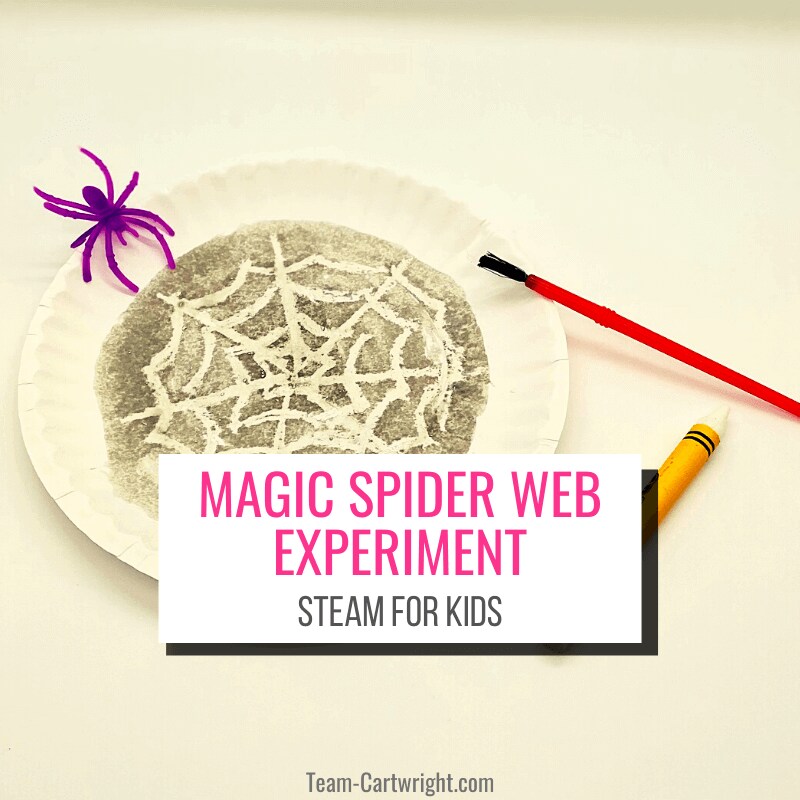
Image via Team Cartwright
Abracadabra! It might seem like magic, but this spider web STEAM craft from Team Cartwright actually doubles as a science experiment. Of course, it takes a bit of secret prep work from grown-ups, who will have to draw a spider web with white crayon on a white paper plate before handing the project off to children. As children unknowingly paint the plate with watercolors, a waxed web will appear. Why? As explained on the Team Cartwright site, the oil-based paraffin wax that makes crayons is hydrophobic, meaning that it repels the water in watercolor paints.
Older children might understand this concept better, although this is an experiment suitable for children of all ages — especially as kiddos watch in awe as their webs emerge and they wonder how it happened. As suggested, they might even want to add paper spiders or stickers and display their DIY decorations.
DIY technology and engineering tasks for Halloween
3. Code a pumpkin offline
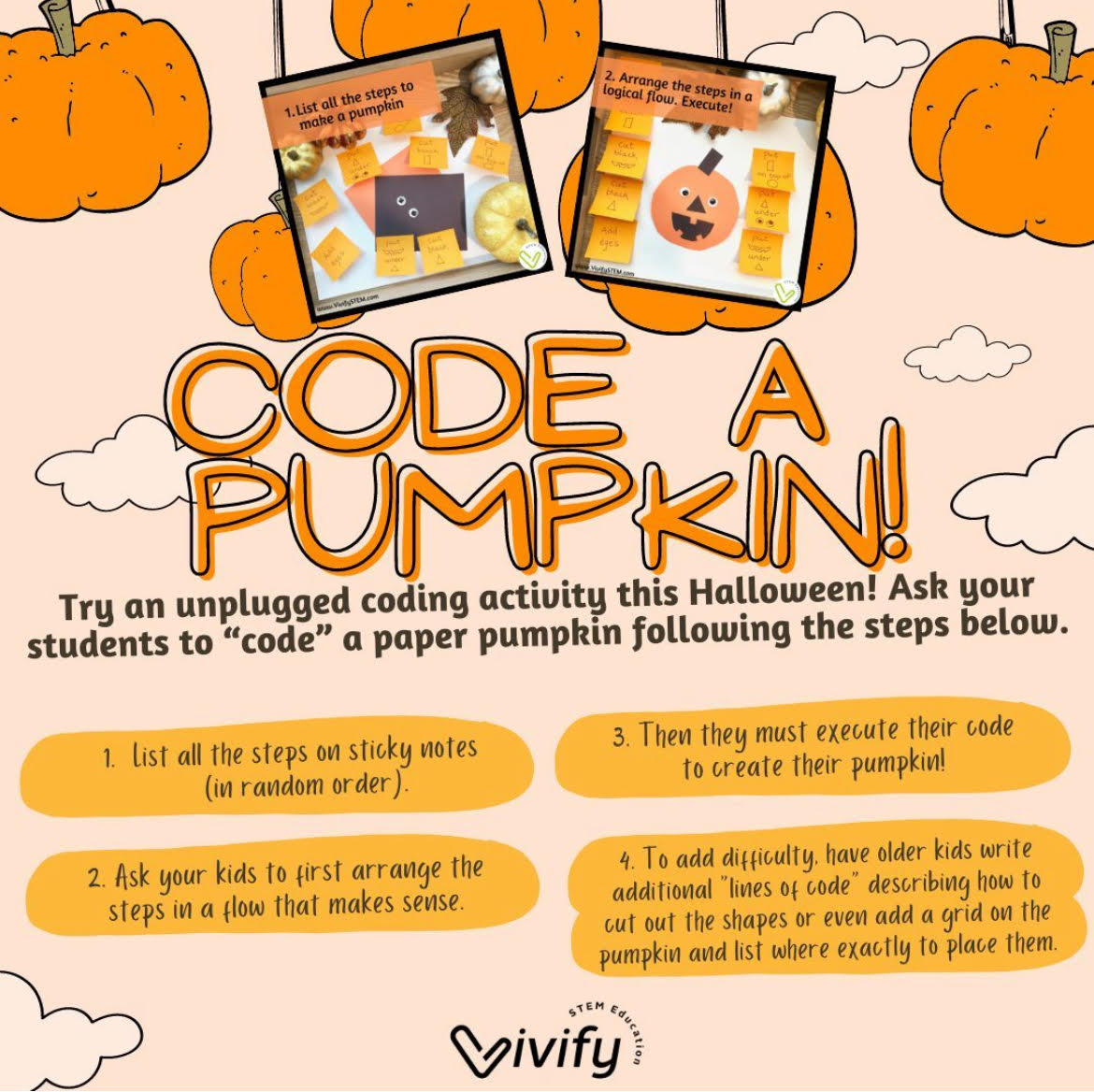
Image via Vivify STEM/Instagram
There’s no computer required for this creative coding lesson from Vivify STEM. Rather children are prompted to design a pumpkin by arranging a pile of prewritten steps in a sensical order — and then carrying out the analog commands using physical materials. (Googly eyes certainly add a nice touch to paper pumpkins and jack-o’-lantern cutouts.)
Younger children will have to draw upon their logic and sequential thinking skills to arrange these steps in order. But Wilkerson recommends older children “tackle the writing of the steps and then give the instructions to another sibling or parent to try it out.Then they can note which steps need clarification, or perhaps are in the wrong order, and then try the process again. It is a great way to iterate on their ‘code’ just like a real computer programmer.”
4. Construct candy corn gears
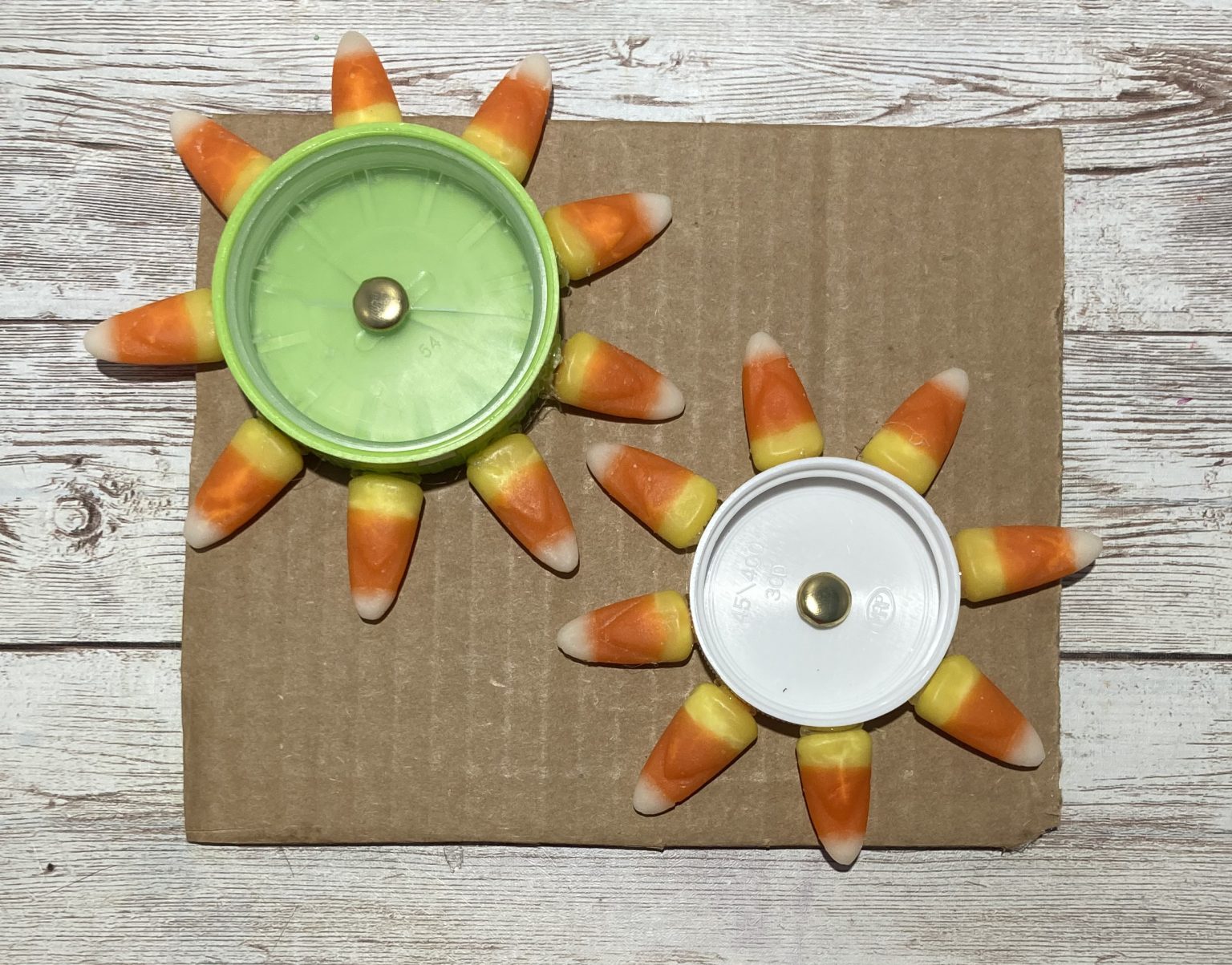
Image via Little Bins For Little Hands
Have children learn all about the mechanics of gears by helping them design their own candy corn machines courtesy of Little Bins for Little Hands. This project — in which the classic Halloween confections act as cogs — requires some specificity and grown-up tools (including a hammer, nails and brads). So be prepared to help young engineers complete the instructions to get their candy corn gears turning and their scientific minds thinking about mechanics and physics principles like direction (do both gears move the same way when turned?) and speed (does the smaller or larger gear turn faster?).
5. Cast a web atop paper cups

Image via stayathomeactivitymom/Instagram
Channel children’s spidey senses (and problem solving skills) with this STEM challenge from Brittany Bacharach of stayathomeactivitymom. Using only cups, craft sticks and toy spiders, this simple activity asks children as young as preschoolers to work together to build a connected spider web upon which to perch their creepy crawly arachnids (don’t let them fall!) — all while encouraging, reads the caption, “collaboration and problem solving, formulating a plan,” oral communication and fine motor skills. Here’s the web creation in action.
Wilkerson adds that collaborative open-ended activities are often key to building a growth mindset and SEL (social-emotional learning) skills. “STEM challenges completed in a group, even with a few siblings, can then turn into collaborative team projects that improve communication, navigating conflict and project management skills,” she explains. “Maybe their design didn’t work the first time. How can they fix this? How can they apply what they know from science to make it better?”
6. Build a home for a ghost
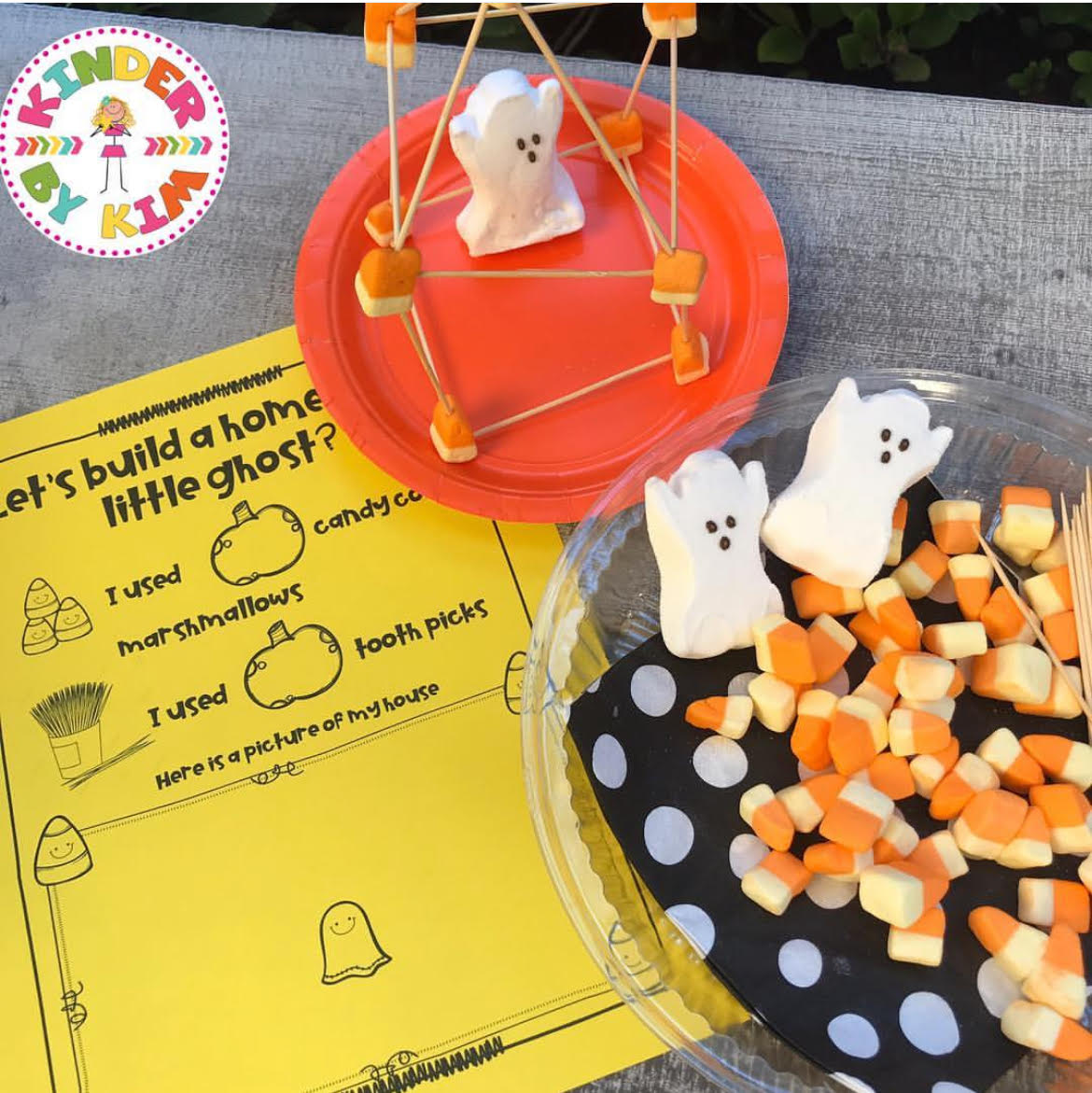
Image via kinderbykim/Instagram
With this project by Kimberly Jordano of kinderbykim, children are asked to put on their architectural and engineering hats to design and build a candy corn and toothpick house for marshmallow ghosts. The activity encourages little builders to problem solve, as well as count the number of materials they use and draw a picture of their creation — which involves so many aspects of STEM learning.
“STEM in kindergarten can help students develop a love of learning, critical thinking, and problem-solving skills,” Jordano tells us. “It can help them build creativity, curiosity and communication skills.”
Jordano’s writes in her post that she tied this activity to the book “Ten Timid Ghosts,” in which the ghosts are banished from their haunted house by a mean witch, therefore giving the children an actual problem to solve and showing how STEM and STEAM concepts can be applied to the real (or in this case imaginary) world. Other books that can provide wonderful STEM activity inspiration are “Creepy Carrots” (build a fence around the carrots!) and “Room on a Broom” (create a broom long enough for all the witch and all her friends!).
7. Power a scribbling spider robot

Image via Science Sparks
Nothing says STEM and STEAM learning like building a robot that can draw. Add a spider theme, a la Science Sparks, and it’s an instant Halloween hit! To build a spider, families can follow these steps to attach pipe cleaner legs, googly eyes and felt-tip pens to the outside of an upside-down container or paper cup.
More technologically-savvy families with older children might create and attach their own circuit to the top of the upside-down container to make the spider move, but the instructions also suggest using a Hexbug toy attached to the top for a similar effect. (While the Hexbug nano packaging indicates that the toys are intended for ages 3 and up, the recommended age for the project is 5 and up with adult supervision at all times.) After giving the robot some juice, uncap those pens and let your scribbling spider robot on the loose! Science Sparks suggests experimenting with different lengths and types of pens to see how the robot scribbles might change.
Projects that call for crafting
8. Create spiders that can climb
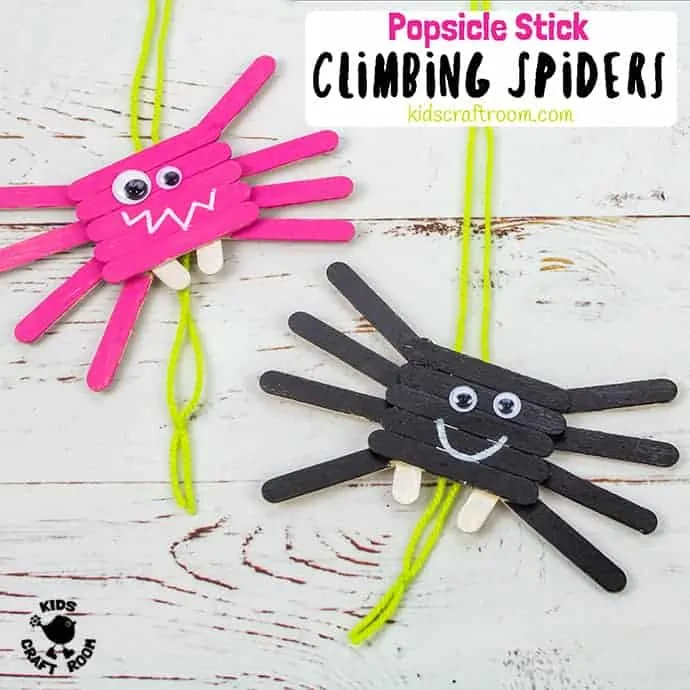
Image via Kids Craft Room
Make the itsy bitsy spider actually crawl up the, well, door with this climbing popsicle stick project from Kids Craft Room. In this two-part project, children (and their grown-up helpers) will first have to craft their spider using the step-by-step tutorial on the site and then create a mechanism (using yarn and a drinking straw) to get their creations to move. To work, the yarn has to be slung over a doorknob and children have to pull the yarn apart at the other end to force the spider to move. Letting go will teach children what happens when gravity is at play, according to the website.
9. Fashion a cardboard costume

Image via Hello, Wonderful
Take a cue from Hello, Wonderful and turn a cardboard box (or two or three) into a DIY Halloween costume that begs children to, well, think outside the box. The possibilities here are endless — as using an open-ended material and one’s imagination to develop the blueprint for a design are the ingredients to the perfect STEM or STEAM recipe.
Should you and your children need some inspiration, Hello, Wonderful’s dino-mite dinosaur costume can be fashioned with just three boxes, some white foam craft board and just seven simple steps. (Note: Spray paint, scissors sharp enough to cut cardboard and a hot glue gun are best left in grown-up hands, making this activity fun for the whole family.)
10. Design your own monster treat bags
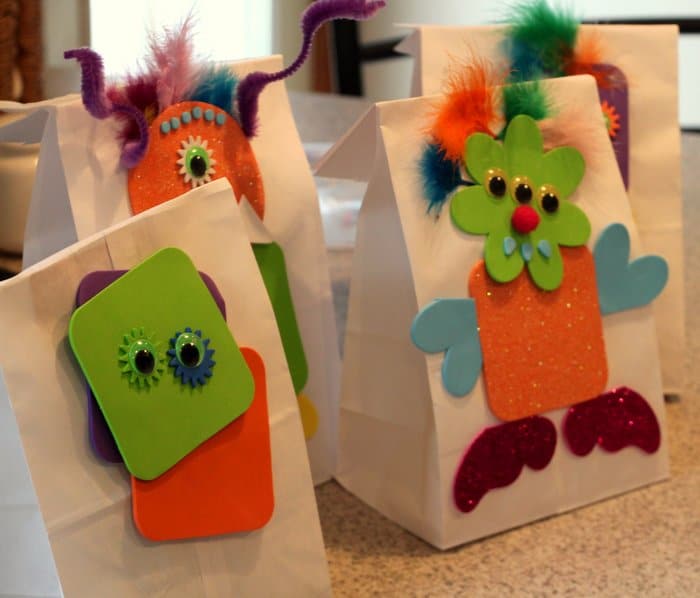
Image via Hands On As We Grow
This open-ended activity from Hands On As We Grow, allows children to use a variety of materials — anything from foam pieces and feathers to glitter and googly eyes — to design their own monsters to adorn DIY treat bags. Whether the monsters look like their imaginary friends or they’re spooky silhouettes created just for the occasion, anything goes.
The only caveat, which adds a problem-solving layer to the design process, is that the monsters should fit the size of the brown paper bag. (These bags can then be used either to collect treats or to give to others, showing children real-world applications for their creations.)
Creative math challenges for Halloween
11. Sort by pumpkin shape

Image via Happy Toddler Playtime
This early-learning math activity from Happy Toddler Playtime helps toddlers and preschoolers practice identifying shapes and sorting materials while engaging their problem solving abilities. Grown-ups will need to prep the hands-on learning experience with Halloween-ified construction paper cutouts. But the rest is up to the (supervised) kiddos as they match foam shapes (either pre-sorted in bowls or after sorting themselves) to the shape outlines affixed to a sticky wall.
Of course, children can practice counting and sorting with a variety of other Halloween goodies, like plastic toys or even their trick-or-treating loot!
12. Make monster-themed origami
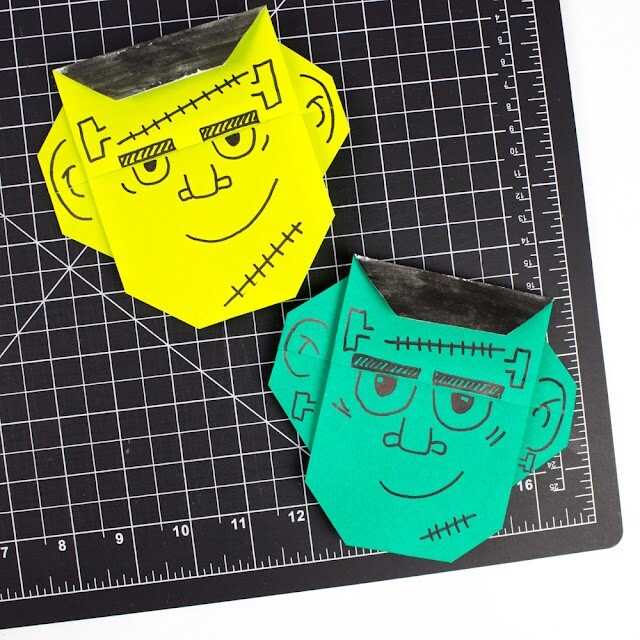
Image via Pink Stripey Socks
Bring a Frankenstein face to life with these simple origami instructions from Pink Stripey Socks that will have children — specifically older children, who have longer attention spans and better fine motor skills — folding, flipping and decorating their monsters.
Yes, origami is specifically the art of folding paper, but it is both an art and a science — one that specifically involves mathematical principles like the creation of shapes, fractions and angles and the utilization of one’s spatial awareness skills to create a 3D object from a flat material. It might also involve some good old-fashioned trial and error as they try to put their own spin (or folds) on how they want their monster to appear.
13. Practice pattern making

Image via Teaching Mama
This simple activity from Teaching Mama is ideal for helping preschoolers practice following and creating patterns — skills that are important for math, science, reading and eventually executing more advanced STEM challenges. Children can use the Halloween-themed color patterns found in the post and Unifix blocks (or really any blocks, bricks or math manipulatives) to complete the challenge. They might even want to have fun creating their own patterns or building structures that included a repeated design.
The bottom line on Halloween STEM activities
Oftentimes, the beauty of STEM activities is that the subject elements of STEM and the skills required to complete them seemingly overlap as children complete tasks, ask questions and continue to explore with the materials in front of them. As Wilkerson notes, “[Children] need to build, break, explore, and work together as they discover the world around them.” Combine that with the thrill of Halloween and you have activities that help little ghosts and goblins learn and grow.





